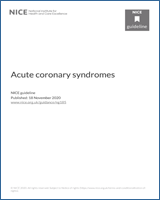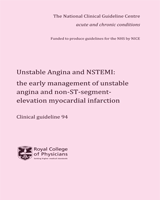1. Guideline title
Acute coronary syndromes: the management of unstable angina and non-ST segment elevation myocardial infarction
1.1. Short title
Acute coronary syndromes: unstable angina and NSTEMI
3. Clinical need for the guideline
The term ‘acute coronary syndromes’ encompasses a range of conditions from unstable angina to ST elevation myocardial infarction (STEMI), arising from thrombus formation on atheromatous plaque. This guideline will address unstable angina and non-ST elevation myocardial infarction. Untreated the prognosis is poor and mortality is high, particularly in people who have had myocardial damage. Appropriate triage and timely use of acute interventions, whether invasive or pharmacological, are vital and will be addressed in this guideline. Timely assessment and classification of those presenting with undifferentiated chest pain are also important and is covered in the acute chest pain guideline being developed in parallel with this guideline see section 4.5.
4. The guideline
The guideline development process is described in detail in two publications that are available from the NICE website (see ‘Further information’). ‘The guideline development process: an overview for stakeholders, the public and the NHS’ describes how organisations can become involved in the development of a guideline. ‘The guidelines manual’ provides advice on the technical aspects of guideline development.
This document is the scope. It defines exactly what this guideline will (and will not) examine, and what the guideline developers will consider. The scope is based on the referral from the Department of Health (see appendix).
The areas that will be addressed by the guideline are described in the following sections.
4.1. Population
4.1.1. Groups that will be covered
Adults (18 years and older), with a diagnosis of unstable angina or non-ST elevation
MI.
Recommendations will be made, as appropriate and based on the evidence, for specific groups:
minority ethnic groups
older people
socio-economic groups
women
people with disabilities
4.1.2. Groups that will not be covered
People with ST segment elevation myocardial infarction
People with an
ACS who have been discharged from hospital..
People with acute heart failure not due to non-ST segment elevation myocardial infarction.
People with undifferentiated chest pain.
4.2. Healthcare setting
The guideline will consider the care received in primary, secondary and tertiary healthcare centres, including care from ambulance teams and other paramedical staff before admission to hospital.
4.3. Clinical management
Risk stratification for triage and management purposes.
Percutaneous coronary intervention (PCI) or early coronary artery bypass grafting (CABG).
Pharmacological therapies, for example antiplatelet drugs, anticoagulants, beta-blockers, angiotensin-converting enzyme (ACE) inhibitors.
Information-giving and communication in the early stage of treatment.
The guideline development group will take reasonable steps to identify ineffective interventions and approaches to care. If robust and credible recommendations for re-positioning the intervention for optimal use, or changing the approach to care to make more efficient use of resources, can be made, they will be clearly stated. If the resources released are substantial, consideration will be given to listing such recommendations in the ‘
’ section of the guideline.
Note that guideline recommendations will normally fall within licensed indications; exceptionally, and only where clearly supported by evidence, use outside a licensed indication may be recommended. The guideline will assume that prescribers will use a drug's summary of product characteristics to inform their decisions for individual patients.
4.4. Status
4.4.1. Scope
This is the final scope.
4.5. Related guidance
The guideline being developed by the National Collaborating Centre for Primary Care ‘Acute chest pain: assessment, investigation and management of acute chest pain of suspected cardiac origin’ will address assessment and examination before diagnosis of the cause of the chest pain.
The following related NICE guidance will also be referred to as appropriate.
Published
MI: secondary prevention. Secondary prevention in primary and secondary care for patients following a myocardial infarction.
NICE clinical guideline 48 (2007). Available from:
www.nice.org.uk/CG048 Guidance on the use of glycoprotein IIb/IIIa inhibitors in the treatment of acute coronary syndromes.
NICE technology appraisal guidance 47 (2002). Available from:
www.nice.org.uk/TA047 -
This TA is being updated by the guideline.
In development
Acute chest pain: assessment, investigation and management of acute chest pain of suspected cardiac origin.
NICE clinical guideline (publication anticipated December 2009).
Laser transmyocardial revascularisation for refractory angina pectoris.
NICE interventional procedure guidance (publication date to be confirmed)
Percutaneous laser revascularisation for refractory angina pectoris.
NICE interventional procedure guidance (publication date to be confirmed)
4.5.1. Guideline
The development of the guideline recommendations will begin in April 2008.
5. Further information
Information on the guideline development process is provided in:
‘The guideline development process: an overview for stakeholders, the public and the NHS’
‘The guidelines manual’.
These booklets are available as PDF files from the NICE website (www.nice.org.uk/guidelinesmanual). Information on the progress of the guideline will also be available from the website.
Referral from the Department of Health
The Department of Health asked the Institute:
To prepare a clinical guideline on the assessment and management of unstable angina and non-ST elevation myocardial infarction.


